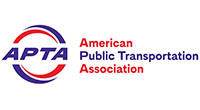Washington, D.C. (June 11, 2021) – At this week’s 2021 APTA-UITP Rail Conference, in a session entitled “Advancing High-Performance Rail Corridors: Making the Business Case”, the American Public Transportation Association (APTA) released a new high-performance rail return on investment report, “Assessing the Business Case ROI for Intercity Passenger Rail Corridor Investment: Guide for Decision Makers”. This new report provides a consistent methodology to quantify the economic and social benefits of passenger rail corridor investments.
The guide, and associated methodology and ROI toolkit, are intended to provide both decision making support and to strengthen public and stakeholder understanding of the full merits of developing high speed and intercity passenger rail projects. It is intended to provide a more expansive view of public benefits and associated return on investment, grounded in economic, environmental, and social equity impacts that are relevant to specific stakeholders, particularly at different levels of government.
“America has an opportunity to build a high-performance rail network to position us to overcome our economic challenges and compete in the global marketplace in the coming years. Passenger rail is an underutilized mode, and ripe to connect with national and local transportation networks and rural areas with high-performance corridor services,” said APTA President and CEO Paul P. Skoutelas. “Development of a national network and national rail plan should be guided by federal, state, and regional planning efforts, and coordinated with the various state-supported intercity passenger rail corridors. The Business Case ROI Tool included with this new guide will be vital to calculating a societal return on investment for intercity passenger rail investments as viewed from the perspectives of these stakeholders.”
Joseph Giulietti, Chair of the APTA Committee on High-Speed and Intercity Passenger Rail, said “I commend the members of APTA and members of the American Association of State Highway and Transportation Officials (AASHTO) for collaborating in the development of the comprehensive new methodology. In earlier corridor studies, certain benefits were too often overlooked. This approach will assure the full range of economic, environmental, and social benefits will be considered.”
APTA continues to strongly advocate for robust investment in America’s passenger rail networks to make our economy stronger, our environment cleaner, and economic and social opportunity more equitable – benefits that will sustain their transformative power over time. To learn more, read APTA’s “Vision for Connecting America’s Urban and Rural Communities with Passenger Rail”.
###
The American Public Transportation Association (APTA) is a nonprofit international association of 1,500 public and private sector organizations which represent a $74 billion industry that directly employs 435,000 people and supports millions of private sector jobs. APTA members are engaged in the areas of bus, paratransit, light rail, commuter rail, subways, waterborne services, and intercity and high-speed passenger rail. This includes: transit systems; planning, design, construction, and finance firms; product and service providers; academic institutions; transit associations and state departments of transportation. APTA is the only association in North America that represents all modes of public transportation. APTA members serve the public interest by providing safe, efficient and economical transit services and products.




